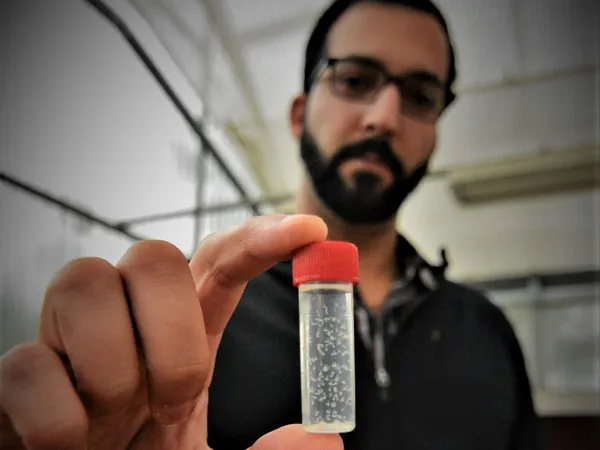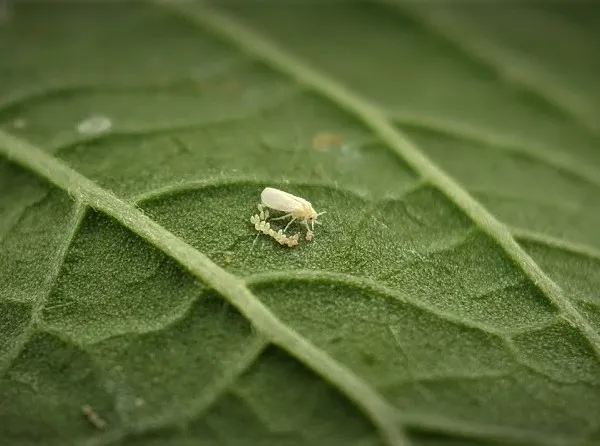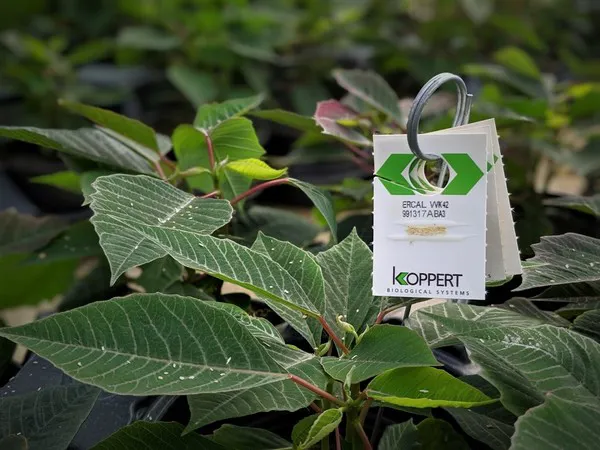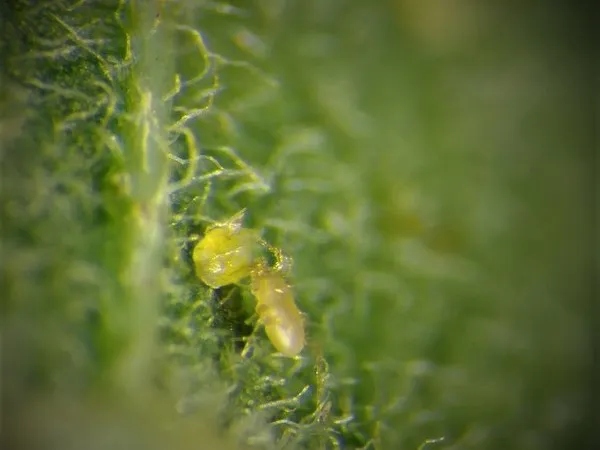A Texas A&M AgriLife Extension Service entomologist is studying how a combination of beneficial insects can help control the pests in greenhouses.
Erfan Vafaie, AgriLife Extension program specialist in Integrated Pest Management, Overton, just wrapped up the second year of a three-year study looking at the use of predatory beneficial insects – mites and wasps – to control sweet potato whiteflies in commercial settings.
Vafaie’s study is for his doctorate dissertation under the supervision of Kevin Heinz, Ph.D., a senior professor in Texas A&M University’s Department of Entomology at College Station.
Whiteflies are sucking insect pests, similar to aphids, and can feed on hundreds of different ornamental, field and vegetable crops. Adults are winged while young whiteflies lie flat against leaves and can be difficult to see with the naked eye.

Erfan Vafaie, Texas A&M AgriLife Extension Service entomologist, Overton, holds a vile filled with whiteflies captured during a trial focused on the use of beneficial insects to control whitefly populations. (Texas A&M AgriLife Extension Service photo by Adam Russell)
They reduce plant growth by consuming plant nutrients, he said. Whiteflies also excrete honeydew, which can lead to sooty mold. Sooty mold will not directly hurt the plant but can reduce plant aesthetics; the most important characteristic for retailing ornamental plants. Left unchecked, whitefly populations can overwhelm and cause mortality to many plants, including poinsettias.
Vafaie said ornamental crops, like poinsettias, are especially vulnerable to decreased marketability and ultimately loss in value from appearance of whiteflies and their feeding. Growers are often aggressively proactive with chemical spray treatments to ensure their poinsettias will meet market demands.
“They’re protective of their crop,” he said. “But the potential for using a combination of biological controls to address a suite of harmful insects instead of conventional chemical controls is something growers are interested in and want to learn more about. I think there are a number of potential benefits to using beneficial insects in commercial settings.”
Fighting pests with predators
Vafaie said there are many questions about pesticide efficacy, pest resistance to certain chemicals, increased pesticide applicator regulations and the overall cost of using pesticides. Consumer trends also show they want ornamentals to have limited-to-no exposure to pesticides.

An adult sweet potato whitefly on the underside of a poinsettia leaf with her recently produced group of eggs. (Texas A&M AgriLife Extension photo by Erfan Vafaie)
Using beneficial insects to control pests and minimize damage to crops could be an important aspect of sustainable production, he said. There are numerous studies showing the effectiveness of using beneficial insects in commercial settings in more temperate climates, especially in fruit and vegetable production, but very little information about how they manage pests of ornamentals in hot, humid areas like East Texas.
Previous studies have tended to focus on the use of a single beneficial insect, such as a parasitic wasp, he said.
“The goal is to determine whether the combination of two beneficial insect species to manage whiteflies can work better than just one for poinsettias in a greenhouse environment,” he said. “I want to know how the wasp and mite work together to suppress whiteflies.”
Vafaie is looking to determine how introducing beneficial predatory mites and parasitic wasps affect the need for pesticide spray treatments. His study started with determining initial whitefly populations on poinsettia cuttings at the grower facilities over two years, whitefly retailer thresholds for two years, and small-scale studies to determine if the combination of the two beneficial insects works better than either one alone.

Parasitic wasps are distributed by hanging cards containing more than 60 wasp pupae per card, and slowly emerge and disperse within the greenhouse. The predatory mites are dispersed using a custom-made blower that distributes the mites on carrier material (wood chip-like material seen on the leaves). (Texas A&M AgriLife Extension photo by Erfan Vafaie)
In the most recent year, Vafaie has focused on commercial trials to manage whitefly populations using beneficial insects in three locations where poinsettias are being grown – two local commercial growers’ greenhouses and Texas A&M AgriLife Research greenhouses holding poinsettia trials in Overton.
The mites, which are tiny spiders, and wasps, which are smaller than fruit flies and do not sting humans, are natural whitefly predators. The mites feed on small soft-bodied insect nymphs and eggs, including eggs and young nymphs of whiteflies and thrips. The wasps lay eggs under middle-aged nymphs, and the young wasps ultimately feed on the whitefly nymphs.
Wasps have a better ability to move around and often encounter dense populations of whiteflies, whereas mites’ dispersal is much more limited, Vafaie said.
Vafaie and his assistant scouted for whiteflies in both greenhouses managed under conventional insecticide rotations and greenhouses that relied mainly on the wasps and mites for whitefly control.
So far, so good
At Location 1, Vafaie said spot sprays were required in addition to the beneficial insects in sections of the greenhouses after whitefly populations moved in. At Location 2, no pesticide applications for whiteflies were necessary in the beneficial insect-managed greenhouse, but fire ant bait was needed to manage the fire ants, which were consuming the beneficial insects.
In Overton, two broadcast applications were needed to bring whitefly populations back down to manageable levels for the beneficial insects.

A predatory mite feeding on a whitefly nymph on the underside of a poinsettia leaf. (Texas A&M AgriLife Extension photo by Erfan Vafaie)
In small-scale trials, Vafaie said the combination of wasps and mites worked as well as either predator alone. Scouting for whiteflies and spot-spraying alone helped decrease the use of pesticides during the study.
Pesticides that do not kill the wasps and mites are typically used, or a spray that will not leave residuals that will harm the beneficial insects following a treatment, he said.
“Throughout the small-scale study, the combination of mites and wasps were more reliable in handling simulated whitefly migrations into the greenhouses,” he said. “Mites are thought to wait and intercept incoming whiteflies, while wasps actively move around and encounter new populations of whiteflies.”
Wasps were released every week while mites were released every four weeks, Vafaie said.
Vafaie said applications of beneficial insects took less time and labor than spray applications. Although the cost of beneficial insects was roughly equivalent to the typical cost of pesticide inputs, a full cost comparison between conventional insecticide rotations and the beneficial insect strategy is still pending.
“The key to this strategy is to use the beneficial insects to maintain whiteflies below the retailer threshold,” he said. “Unlike pesticide applications, biological control is a numbers game; each beneficial insect can only eat or lay eggs under so many whiteflies for a given period of time. If whiteflies are reproducing at a faster rate than the beneficial insects can consume, then it’s time to knock down whitefly population with some selective pesticides to levels manageable by the beneficial insects again.”
Vafaie hopes to extend the study further and incorporate an economist to analyze the cost benefits of using beneficial insects compared to conventional preventative insecticide rotations for commercial poinsettia production.
Source: AgriLife Today (Adam Russell)
